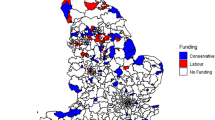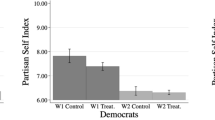8. Summary
Our most robust findings can be summarized as follows:
u
-
The spatial location of candidates is important in determining the pattern of campaign contributions. Many PACs and all PAC types, except agricultural cooperatives, contribute in a manner highly consistent with a simple spatial model. There is little giving by an individual PAC to candidates at opposite ends of the dimension. There is no instance of a PAC contributing to incumbents located at each end of the dimension and only to challengers of incumbents in the middle (or vice versa). Contributions against incumbents (i.e., to challengers of incumbents) are often spatial mirror images of a PAC's giving in favor of incumbents, though this statement must be tempered by the fact that the large majority of PACs give relatively little money to challengers. Few PACs give money to both challenger and incumbent in the same race. Giving in open-seat races is, if anything, even more spatially consistent than in races where an incumbent is running.
-
While many individual PACs exhibit patterns of contributions consistent with the "ideological" dimension, the data for 1980 suggest that there was no particular bias toward one end of the spectrum or the other. Taking all PACs together essentially eliminates the effect of the location variable in the regressions. Giving in races with an incumbent on the ballot was, overall, balanced across the dimension.
-
There are, however, “ideological” distinctions even among groups as broadly defined as the FEC categories. For the Corporate, Labor, and Trade/Membership/Health groups, the incumbent's location on the “ideological” dimension is an important explanatory variable even when other factors specific to the incumbent are considered. (Of course, “ideology” matters to Nonconnected groups, too. They just tend to balance each other off in positive money, though not in negative.) On average, Corporate and Trade groups favor conservative incumbents and opponents of liberal incumbents. Labor PACs do the opposite.
-
Except for Labor PACs, party is not an important variable in explaining positive contributions, once the incumbent's voting record is taken into account. For contributions to challengers, however, party is significant. Corporate, Nonconnected, and Trade PACs gave to opponents of Democrats. Labor PACs did the opposite.
-
The expected closeness of the election is always an important variable. Both positive money and contributions to challengers increase as the probability of a strong challenge increases. This suggests that PACs are sensitive to the potential impact of contributions on electoral outcomes.
-
Although committee assignments have some importance in explaining campaign contributions by PAC categories, their net effect is never strong, except in the case of Cooperatives. This is almost certainly because of the diversity of interests represented by PACs in every category except Coops, which are essentially one giant PAC of milk producers. We would surmise that competitive forces in the House result in most members having a portfolio of committee assignments that provides maximum advantage vis-a-vis each member's constituency. It would therefore be surprising if, overall, committee assignments by themselves pointed to significant differences in generating campaign resources. Being chairman or ranking minority member of a committee has no impact on campaign contributions, other things equal.
-
Seniority, as measured by number of consecutive years in office, has a complicated role. For positive contributions, seniority has a nonmonotonic effect, with contributions being higher for the most junior and most senior members, ceteris paribus, than for incumbents with average seniority. Negative contributions, however, are not significantly related to seniority.
We hasten to stress that what this paper reports is an overview of a large body of data. Our focus is mostly on patterns by broad categories of PACs. For some groups (Labor PACs and Agricultural cooperatives), these categories are quite homogeneous. For others (Nonconnected PACs, Corporate, and Trade PACs), there is considerable heterogeneity. This is apparent from the fairly high level of unexplained variance in most of our regressions, though we note that we did not engage in much fit-improving activity. Yet even within these broad categories, systematic patterns emerge. The large body of data available from 1980 on is a rich potential source of further investigation, both at the aggregate level (e.g., replicating for later years the kinds of things we have done for 1980) and for looking at individual PACs in greater detail.Footnote 1 Ours is but a glimpse at the rough outlines.
As to more detailed analysis, it would be interesting to look, for example, at corporate PACs by industry type and other characteristics. This would complement the work of Handler and Mulkern (1982), who studied the internal organization of 71 business PACs. Eismeier and Pollock (1984) use FEC data on total contributions (including Senate and Presidential races) for 1980 to analyze PACs by characteristics such as type, size, industry, and having an office in Washington. Their perspective is quite different from that of our paper.
Similar content being viewed by others
Notes
Replication across years would be particularly useful in light of the contention that 1980 may have been somewhat atypical, especially in the role of ‘ideological’ PACs and the ascendancy of conservative candidates. Casual inspection of aggregate data for 1982 does not suggest dramatic differences in overall patterns, except that contributions increase in every category. The role of PACs as a component of overall campaign finance is also increasing. (See, e.g., Jackson, 1984.)
References
Alexander, H.E. (1983) Financing the 1980 Election. Lexington, Massachusetts: D.C. Heath.
Aranson, P.H. and Hinich, M.J. (1979) Some Aspects of the Political Economy of Election Campaign Contribution Laws. Public Choice, 34: 435–461.
Austen-Smith, D. (1983) Interest Groups, Campaign Contributions, and Spatial Voting. GSIA Working Paper 59-82-83, Carnegie-Mellon University.
Bullock, C.S., III. (1981) Congressional Voting and Mobilization of a Black Electorate in the South. Journal of Politics, 43: 662–682.
Chappell, H.W., Jr. (1981) Campaign Contributions and Voting on the Cargo Preference Bill: A Comparison of Simultaneous Models. Public Choice, 36: 301–312.
Coombs, C. (1964) A Theory of Data. Ann Arbor: Wiley.
Drew, E. (1983) Politics & Money: The New Road to Corruption. New York: Macmillan.
Eismeier, T.J. and Pollock, P.H., III. (1984) Political Action Committees: Varieties of Organization and Strategy. (ed.) M.J. Malbin, Money and Politics in the United States. Chatham, N.J.: Chatham House.
Ferejohn, J. and Noll, R. (1984) Campaign Contributions and Lobbying Activities as Reputational Phenomena. Manuscript. Presented at the Congerence on the Political Economy of Public Policy, Stanford University.
Fiorina, M. (1977) Congress: Keystone of the Washington Establishment. New Haven: Yale University Press.
Handler, E. and Mulkern, J.R. (1982) Business in Politics. Lexington, Massachusetts: D.C. Heath.
Hinich, M.J. (1977) A Model for Campaign Contributions. (Eds.) R. Auster and B. Sears, American Re-Evolution. Tucson: University of Arizona Press.
Jackson, B. (1984) House Reelection Campaigns—More Incumbents Turn to PACs. Wall Street Journal, May 1.
Jacobson, G.C. (1980) Money in Congressional Elections. New Haven: Yale University Press.
(1985) Money and Votes Reconsidered: Congressional Elections, 1972–1982. Public Choice, this issue.
Kau, J.B. and Rubin, P.H. (1982) Congressmen, Constitutents, and Contributors. Boston: Martinus Nijhoff.
Malbin, M.J. (1980) (Ed.) Parties, Interest Groups, and Campaign Finance Laws. Washington: American Enterprise Institute.
Morrison, R.J. (1972) A Statistical Model for Legislative Roll Call Analysis. Journal of Mathematical Sociology, 2: 235–247.
Poole, K.T. (1981) Dimensions of Interest Group Evaluation of the U.S. Senate, 1969–1978. American Journal of Political Science, 25: 49–67.
(1982) Least Squares Multidimensional Unfolding with Applications to Political Data. Manuscript. Presented at 1982 Meeting of the Midwest Political Science Association, Milwaukee.
(1984) Least Squares Metric, Unidimensional Unfolding. Psychometrika, 49: 311–323.
and Daniels, R.S. (1985) Ideology, Party, and Voting in the U.S. Congress, 1959–1980. American Political Science Review, 79: in press.
and Rosenthal, H. (1984a) Extremism, Intensity, and Perception in Congressional Voting. GSIA Working Paper 33-83-84, Carnegie-Mellon University.
and (1984b) The Polarization of American Politics. Journal of Politics, 46: in press.
and (1985) A Spatial Model for Legislative Roll Call Analysis. American Journal of Political Science, 29: in press.
Weisberg, H.F. (1978) Evaluating Theories of Congressional Roll-Call Voting. American Journal of Political Science, 22: 554–578.
Welch, W.P. (1980) The Allocation of Political Monies: Economic Interest Groups. Public Choice, 35: 97–120.
(1981) Money and Votes: A Simultaneous Equation Model. Public Choice, 36: 209–234.
Additional information
Graduate School of Industrial Administration, Carnegie-Mellon University. We thank the Center for the Study of Public Policy at CMU for funds for data acquisition, and the National Science Foundation for research support. Allan Meltzer's editorial suggestions and comments by Conference participants have been most helpful.
Rights and permissions
About this article
Cite this article
Poole, K.T., Romer, T. Patterns of political action committee contributions to the 1980 campaigns for the United States House of Representatives. Public Choice 47, 63–111 (1985). https://doi.org/10.1007/BF00119353
Issue Date:
DOI: https://doi.org/10.1007/BF00119353




